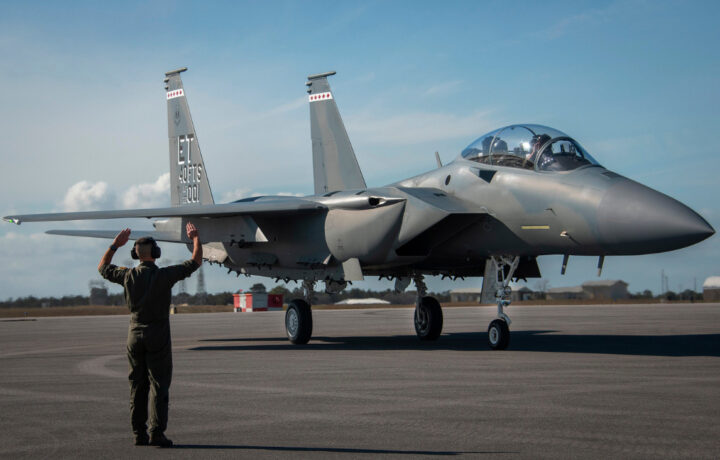As many as 90 additional Boeing F-15EX Eagle II jet fighters could be “hatched” his year, the aerospace firm announced, as it has begun deliveries of Lot 2 of the modernized warbird. Nine F-15EX aircraft have rolled off the assembly line, with six of the 4.5-generation jets employed as test aircraft.
The first operationally configured Eagle II was delivered to the Oregon Air National Guard last June, while a second one completed deliveries of Lot 1 orders to the ANG unit last summer. The 173rd Fighter Wing at Kingsley Field Air National Guard Base (ANGB), Oregon, became the first F-15EX formal training unit in 2024.
Not a Lot More F-15EX Fighters in Lot 2
Though Lot 1 consisted of just nine fighters, Lot 2 increased the number of fighters to be delivered. The first Lot 2 aircraft, tail number 009, arrived with the Oregon ANG earlier this month.
The second lot will consist of 12 Eagle IIs, all set for delivery before the end of calendar year 2025. Flight Global reported that Boeing has set a goal of reaching an assembly rate of two aircraft per month by 2026. Final assembly of the modernized variant of the venerable McDonnell Douglas F-15 Eagle is completed at Boeing’s facility in St. Louis, MO.
Boeing, which merged with McDonnell Douglas in 1997, has been striving to increase workflow. It introduced an internal campaign known as “Cut the CoRRS” (Cost of Rework and Rejected Standards). It includes a daily “Quality Power Hour” that allows teams to address production issues, preventing delays and defeats.
“Factory performance has been improving in recent months, with rework and traveled work rates decreasing month over month, enhancing workflow productivity and supporting factory stabilization,” Tom Altamuro, Boeing’s director of F-15 manufacturing and safety, told reporters.
A Modernized Eagle
Though the F-15EX lacks the stealth capabilities of Lockheed Martin’s fifth-generation F-35 Lightning II, a selling point has been that the Eagle II could replace the aging F-15 Eagles that have been in service for decades. The United States Air Force retains the largest F-15 fleet in the world, and the F-15EX aircraft could allow for a more seamless transition.
Boeing has maintained that the Eagle II will not require new logistics chains, training squadrons, infrastructure modification, program offices, or even weapons integration.
The F-15EX is a two-seat fighter with capabilities that are entirely unique to the U.S. Air Force. That includes new fly-by-wire flight controls, improved weapons stations, and an enhanced electronic warfare suite, as well as advanced radar and computers, conformal fuel tanks, and a strengthened airframe. The Eagle II offers a deep magazine, allowing it to carry a load of advanced weapons, with a 28% larger payload than the older F-15E Strike Eagle variant. At the same time, the Eagle II will require only minimal transitional training and little additional manpower from the older versions of the F-15.
Boeing has touted that the production of the Eagle II has required minimal infrastructure changes. At the same time, the Air Force has estimated that F-15EX Eagle IIs share about 70% of parts with the current F-15C and F-15E variants being replaced.
Some Air Force officials and aviation analysts have expressed concerns that the F-15EX hasn’t been as cheap as expected. The F-15EX was found to have a higher “flyaway cost” than the F-35. However, a study by the D.C.-based Government Accountability Office conducted last year found that the Eagle II achieved an 83.13% mission-capable rate, compared with the Lightning II’s MC rate of 67.15% for all variants.
The McDonnell Douglas F-15 Eagle first took flight in 1972, and it entered service with the U.S. Air Force in 1976. It remains among the most successful modern fighters every produced, and to date, not a single aircraft has been lost in aerial combat. More than 1,500 F-15s are in service worldwide – and both the Air Force and U.S. Air National Guard continue to operate the aircraft. The F-15EX Eagle II will ensure that the aircraft remains in service for decades to come.




